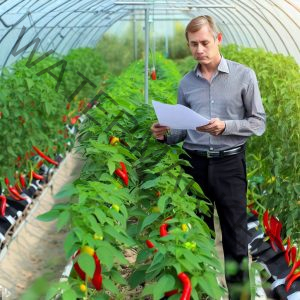Starting a tomato greenhouse business requires careful planning and strategic implementation. A well-crafted business plan can serve as a roadmap to guide you through the process and increase your chances of success in the competitive agricultural industry.
This article provides a comprehensive overview of the key elements to consider when developing a tomato greenhouse business plan. From market analysis and financial projections to production strategies and marketing techniques, we will explore the essential aspects of establishing and operating a profitable tomato greenhouse venture.
[Pdf Sample] Tomato Greenhouse Business Plan Proposal Docx
To write a business plan, here is a breakdown of how it should be structured and what should be in each category. After this instruction, I will provide you with a sample of one I wrote for my farm, let us go:
Read Also: [Pdf Sample] Business Plan For Vegetable Farming Docx

Executive Summary
The executive summary provides a concise overview of your tomato greenhouse business plan. It summarizes the key elements of your venture, including your mission statement, market analysis, competitive advantages, and financial projections. The executive summary serves as a hook to grab the reader’s attention and provide a snapshot of your business idea.
Market Analysis
In the market analysis section, you will delve into the tomato industry, evaluating the demand and trends, competition, and potential market segments. This analysis will help you identify your target market and develop strategies to position your greenhouse business effectively.
Read Also: [Pdf Sample] Business Plan Guide For Strawberry Farming Docx
Target Market and Customers
Understanding your target market and customers is crucial for developing a successful tomato greenhouse business plan. Identify the demographics, preferences, and needs of your potential customers. Determine if you will focus on supplying local restaurants, grocery stores, or direct-to-consumer sales.
Greenhouse Infrastructure
Designing an efficient greenhouse infrastructure is paramount for optimal tomato production. Discuss the layout, size, materials, and technologies you will utilize to create a conducive environment for the growth of healthy and high-yielding tomato plants.
Read Also: [Pdf Sample] Business Plan For Bell Pepper Farming Docx
Tomato Cultivation Techniques
This section will outline the cultivation techniques you will employ in your greenhouse. Discuss seed selection, propagation methods, irrigation systems, nutrient management, pest and disease control, and harvesting techniques. Emphasize sustainable and organic practices to attract environmentally conscious customers.
Supply Chain Management
Managing the supply chain effectively is crucial for maintaining the quality and freshness of your tomatoes. Describe your strategies for sourcing inputs, managing inventory, packaging, and distribution. Ensure that your supply chain is streamlined to deliver fresh tomatoes promptly.
Marketing and Sales Strategies
Developing robust marketing and sales strategies will help you create awareness and attract customers to your tomato greenhouse business. Discuss your branding, promotional activities, pricing strategies, and distribution channels. Leverage digital marketing techniques to reach a wider audience and establish an online presence.
Read Also: [Pdf Sample] Business Plan For Chili Pepper Farming Docx
Financial Projections
The financial projections section presents a comprehensive analysis of the expected costs, revenues, and profitability of your tomato greenhouse business. Include information on initial investments, operational expenses, sales forecasts, and return on investment. Seek professional assistance if needed to ensure accurate financial projections.
Risk Assessment and Mitigation
Identify potential risks and challenges that may impact your tomato greenhouse business. Assess market risks, natural disasters, pests and diseases, and regulatory changes. Develop contingency plans and mitigation strategies to minimize the impact of these risks.
Operational Plan
The operational plan outlines the day-to-day activities and processes involved in running your tomato greenhouse business. Define your production schedule, quality control measures, equipment maintenance, and record-keeping procedures. Focus on operational efficiency to maximize productivity and minimize costs.
Human Resources Management
Discuss the human resources required for your tomato greenhouse business. Determine the number of staff needed, their roles and responsibilities, and the skills and qualifications required. Outline a recruitment and training plan to ensure a competent and motivated workforce.
Legal and Regulatory Considerations
Complying with legal and regulatory requirements is essential for operating a tomato greenhouse business. Research the necessary permits, licenses, and certifications required in your locality. Ensure adherence to food safety and environmental regulations to build trust with customers and avoid legal issues.
Sustainability Practices
Integrating sustainable practices into your tomato greenhouse business can attract environmentally conscious consumers and enhance your brand reputation. Explore options such as water conservation, renewable energy sources, waste management, and eco-friendly packaging.
Expansion and Growth Opportunities
As your tomato greenhouse business thrives, consider expansion and growth opportunities. Explore diversification into other crop varieties, regional market expansion, or value-added products. Develop a long-term vision for your business and set goals to guide its growth.
Here Is The Download Link To Business Plan Proposal For Tomato Greenhous Farming By Agrolearner
Business Model: Agrolearners.com’s Tomato Greenhouse Farm
Value Proposition:
Agrolearners.com’s Tomato Greenhouse Farm provides high-quality, organic tomatoes to health-conscious consumers, local grocery stores, restaurants, and food processors in the surrounding region. We offer fresh, flavorful tomatoes grown sustainably without the use of harmful chemicals, ensuring superior quality and nutritional value.
Key Activities:
Tomato cultivation using advanced greenhouse infrastructure and technology-driven techniques.
Supply chain management, including sourcing agricultural inputs, quality control, and distribution.
Marketing and sales strategies to reach and engage the target market.
Continuous research and development to enhance cultivation techniques and improve crop quality.
Customer Segments:
Health-conscious consumers seeking fresh, organic tomatoes.
Local grocery stores, restaurants, and food processors in need of a reliable supplier of premium-quality tomatoes.
Customer Relationships:
Building strong relationships with customers through consistent delivery of high-quality tomatoes.
Engaging with customers through social media, direct sales, and participation in farmers’ markets to gather feedback and understand their evolving needs.
Providing excellent customer service and addressing any concerns promptly.
Revenue Streams:
Direct sales to consumers and businesses.
Wholesale contracts with grocery stores, restaurants, and food processors.
Value-added tomato products, such as sauces and dried tomatoes.
Key Resources:
Greenhouse infrastructure with automated climate control, irrigation systems, and energy management solutions.
Skilled agricultural professionals, farm managers, and greenhouse technicians.
Strategic partnerships with suppliers for seedlings, fertilizers, and other agricultural inputs.
Marketing and sales team to promote and sell products.
Financial resources for investments and operational expenses.
Key Partnerships:
Suppliers of agricultural inputs, ensuring a steady and reliable supply of quality seedlings, fertilizers, and other necessary materials.
Local grocery stores, restaurants, and food processors, establishing long-term partnerships for consistent sales and distribution.
Collaboration with local agricultural research institutions and industry experts to stay up to date with the latest cultivation techniques and market trends.
Channels:
Online platforms and Agrolearners.com website for product promotion and direct sales.
Social media marketing to reach and engage with target customers.
Direct sales to local businesses, establishing personal relationships and ensuring product quality.
Participation in farmers’ markets and trade shows to showcase products and connect with customers.
Cost Structure:
Greenhouse infrastructure setup and maintenance costs.
Employee salaries and benefits.
Marketing and advertising expenses.
Cost of agricultural inputs, including seedlings, fertilizers, and pest control measures.
Administrative and operational costs, including utilities, packaging, and transportation.
Key Metrics:
Sales revenue and growth rate.
Customer satisfaction and retention rates.
Yield per square meter and production efficiency.
Cost per kilogram of tomatoes.
Market share and customer acquisition rate.
By implementing this business model, Agrolearners.com’s Tomato Greenhouse Farm aims to establish itself as a reliable supplier of premium-quality tomatoes while promoting sustainable agriculture practices. The combination of advanced greenhouse infrastructure, technology-driven cultivation techniques, efficient supply chain management, and a customer-focused approach positions the farm for success in meeting the increasing demand for fresh, organic tomatoes in the local market.
How much capital do I need to start a tomato greenhouse business?
The capital required to start a tomato greenhouse business can vary depending on factors such as the size of the greenhouse, equipment costs, and initial operational expenses. It is recommended to conduct a detailed financial analysis and seek professional advice to determine the exact capital requirements for your specific business.
Are there any specific licenses or permits needed for operating a tomato greenhouse business?
The licenses and permits required for operating a tomato greenhouse business may vary depending on your location. It is important to research and comply with local regulations regarding agricultural operations, food safety, and environmental standards. Consult with local authorities or agricultural extension services to ensure you meet all the necessary requirements.
How can I market my tomatoes effectively?
To market your tomatoes effectively, develop a strong brand identity, create a compelling online presence, and utilize various marketing channels such as social media, local farmers’ markets, and partnerships with local restaurants or grocery stores. Emphasize the quality, freshness, and sustainability of your tomatoes to attract customers who value these attributes.
What are some common challenges faced in tomato greenhouse farming?
Common challenges in tomato greenhouse farming include pest and disease management, maintaining optimal growing conditions, market fluctuations, and competition. It is important to stay updated with the latest agricultural practices, invest in technology and infrastructure, and adapt to changing market dynamics to overcome these challenges successfully.
How can I ensure the quality and freshness of my tomatoes during transportation?
To ensure the quality and freshness of your tomatoes during transportation, use proper packaging that protects the fruits from damage and maintains their freshness. Consider using temperature-controlled vehicles or refrigerated containers to preserve the quality during transit. Efficient supply chain management and prompt delivery are crucial for maintaining the freshness of your tomatoes.
Conclusion:
Agrolearner.com Farm’s tomato greenhouse farming business plan outlines a comprehensive strategy to capture the growing demand for high-quality tomatoes in our target market. With our focus on sustainable practices, advanced cultivation techniques, and efficient supply chain management, we are confident in our ability to deliver superior products while maintaining profitability. We are excited to embark on this journey and contribute to the local agriculture industry while providing consumers with healthy, flavorful tomatoes.




Hello. I have read this section about Tomato Greenhouse Business Plan and I wonder if You have this business plan in a PDF file and You may send me to My e-mail?
Thank You.
Have a Great Day.
Definitely I have it, drop your email to get a copy of it